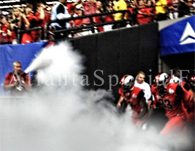FAQs
Q: Where is Carbon Dioxide (CO2) used?
A: Carbon dioxide is used to produce carbonated soft drinks and soda water. Some fire extinguishers also use carbon dioxide. Carbon dioxide is released by baking powder or yeast making cake batter rise. Carbon dioxide is one of the most commonly used compressed gases for pneumatic (pressurized gas) systems in portable pressure tools. Life jackets often contain canisters of pressured carbon dioxide for quick inflation. Aluminum containers of CO2 are also sold as consumer supplies as a source of compressed gas for airguns, paintball markers, and inflating bicycle tires.
 CO2 effects are used in live performances, corporate entertainment venues, indoor and outdoor sporting events, nightclubs, bars, outdoor and indoor concerts, stage performances, theatre, movies, music videos and more. Liquid CO2 is used in certain fog machines creating thicker, more consistent low-lying fog effects. "This is truly one of the most extreme and impressive special effects that can be accomplished outside of any governing regulations. When used correctly and all precautions in mind, this is a very safe effect that can be used over and over again without incident to produce a truly awe inspiring effect." (Fire Marshal Friendly Special Effects: HauntWorld, 2011.)
CO2 effects are used in live performances, corporate entertainment venues, indoor and outdoor sporting events, nightclubs, bars, outdoor and indoor concerts, stage performances, theatre, movies, music videos and more. Liquid CO2 is used in certain fog machines creating thicker, more consistent low-lying fog effects. "This is truly one of the most extreme and impressive special effects that can be accomplished outside of any governing regulations. When used correctly and all precautions in mind, this is a very safe effect that can be used over and over again without incident to produce a truly awe inspiring effect." (Fire Marshal Friendly Special Effects: HauntWorld, 2011.)
Q: What is Carbon Dioxide (CO2)?
A: Carbon dioxide is one of the most abundant nonflammable, colorless, and usually odorless gasses in the earth's atmosphere. Carbon dioxide is a by-product of combustion and is emitted from volcanoes, hot springs, and geysers. Carbon dioxide plays an important part in vital plant and animal processes, such as photosynthesis and respiration (plants convert carbon dioxide and water into food compounds, such as glucose, and oxygen). Carbon dioxide is essential for internal respiration in the human body.
Aside from being an essential element in nature and humans, carbon dioxide is known to cause health effects when the concentration levels exceed a certain limit, especially in confined or unventilated areas. Various toxicity studies and exposure recommendations exists from the U.S. Occupational Safety and Health Administration, the U.S. National Institute for Occupational Safety and Health (NIOSH) and American Conference of Government Industrial Hygienists (ACGIH) as well as independent physiological experiments. Solid carbon dioxide's temperature is below -108.4 ºF at regular atmospheric pressure, frostbite can occur with improper handling. Liquid CO2 exists at high pressure, roughly 1,000 PSI.